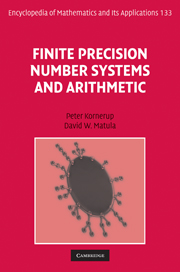3 - Addition
Published online by Cambridge University Press: 05 March 2013
Summary
Introduction
Just as the radix representation is the ubiquitous representation of numbers, so radix integer addition is the most fundamental operation for all computer arithmetic; it is used in the implementation of all the other standard arithmetic operations: subtraction, multiplication, division, and square root. For a discussion of the implementation of the standard arithmetic operators on simple radix-represented operands, it is sufficient to consider integer operands. The modifications necessary to extend the algorithms and hardware implementations to other types of fixed-point operands are very trivial. Also the problem of subtraction is trivially reduced to addition, so we shall only briefly cover subtraction in the following.
It is, however, crucial to the discussions in this chapter that we restrict ourselves to a finite set of integer values, as typically defined by the limitations of computer words or registers used in hardware implementations. Radix integer addition on such restricted operand domains then forms the most basic “building block” upon which other radix integer arithmetic operations can be built. Eventually we will also build other finite precision arithmetic systems on these radix integer operations, e.g., floating-point arithmetic and more unusual or exotic types of arithmetic based on other number representations, like rational representations. Even the types of “exact” or unlimited precision arithmetic found in symbolic and algebraic systems are based on these basic “building block” integer arithmetic operations.
Information
- Type
- Chapter
- Information
- Finite Precision Number Systems and Arithmetic , pp. 119 - 206Publisher: Cambridge University PressPrint publication year: 2010
